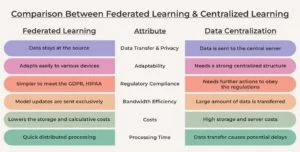Companies are always on the lookout to find the best ways to manage and process the information and data that they possess, especially with the expansion of AI and data analytics. The predominantly used method is data centralization, in which all of the data is gathered and saved in the centralized servers or data centers for processing.
But this method has its downsides with concerns like privacy, security, and compliance. Therefore, a new and innovative alternative solution has appeared in Federated Learning (FL).
Now, there is curiosity about Federated learning vs Centralized learning to determine which method delivers better results. In this blog, we will discuss that.
Federated Learning vs Centralized Learning: How Do They Differ?
Before we get into federated learning vs centralized learning, let’s understand them individually.
What is Data Centralization?
As the name centralization suggests, data centralization is a method where data is gathered from various sources and then stored in a single repository. Essentially, the information is stored in a single location, such as a centralized cloud or data center. This method has been in place for years for the AI and data analytics strategies.
How Does Data Centralization Work?
The procedure for how it works is straightforward.
Data is extracted from dispersed users, entities, or devices.
Data is transferred for processing to a single location or the central server.
Storage and processing of the information is next in line. Here, the data is cleaned, organized, and utilized to educate AI models or analytics.
The model distributes results after it is generated, to be applied throughout various devices or systems.
Benefits that Data Centralization Offers
Ease of Integration – It integrates seamlessly with various traditional AI and analytics structures.
Smooth management and access – The data is in one place, making administration and processing easier.
Computational ability – Centralized clouds or data centers can utilize specialized hardware to train complex models.
Challenges with Data Centralization
Lags and Efficiency – When data is transferred from various sources to the central server, it can sometimes cause delays, which can lead to inefficiency issues.
Compromise in Security – When a large amount of data is stored in one place, it is prone to cyberattacks. Any successful cyberattack or data breach can put a significant amount of data at risk.
Costs – The infrastructure to store and process a massive amount of data is expensive. Cost-cutting in setting up the infrastructure can make the data prone to security risks and incur additional expenses.
Regulatory Compliance – When data is stored on an external server, meeting the criteria of regulatory compliance standards like GDPR and HIPAA becomes challenging.
What is Federated Learning?
It is a method of AI that does not require data to be transferred to a centralized server to train the models. Instead, data is stored on local devices, and only upgrades for the models are aggregated.
How Does Federated Learning Work?
Division of Model – Each device or node receives the first model with local data.
Training the Model – Each node educates the model in a non-centralized way by utilizing the data it possesses.
Aggregating the Updates – The model’s parameters and adjustments are sent instead of sharing the raw data.
Results – A central server merges updates from the various nodes to upgrade the global model without altering the original information.
Benefits that Federated Learning Offers
Better Privacy – Data stays with the source, thereby reducing the likelihood of data breaches.
Adaptability – It is an adaptable process that can be used across various devices and settings without the need for large data centers.
Uncomplicated Regulatory Compliance – Simpler to obey the data protection regulations.
Reduction in Bandwidth Utilization – As only the updates for the models are sent, and not the raw data, a reduction in bandwidth utilization can be observed.
From this quick comparison table, Federated Learning has advantages over data centralization, making it a better choice for delivering better results.
Federated Learning vs Centralized Learning: How Do They Compare?
From this quick comparison table, we can point out that Federated Learning has advantages over data centralization, which makes it a choice to deliver better results.
Parting Words to Keep in Mind
Although data centralization has long been the norm for AI model training, issues with privacy, security, cost, and scalability limit its usefulness.
Federated Learning is a cutting-edge method that enables the training of AI models without sacrificing data privacy or requiring expensive infrastructure.
From the perspective of Federated Learning vs Centralized Learning, the former prioritizes data privacy and reduces bandwidth usage by keeping data on-device. Centralized learning offers simplicity and direct control over training data. Developers should base their choice on the use case.
At the same time, centralized systems work best in situations where data aggregation is practical and privacy issues are controllable, like internal enterprise analytics. In Federated Learning vs Centralized Learning, federated systems work best with sensitive or widely dispersed data (e.g., smart keyboards that get better without sharing user text).
Federated Learning provides a secure and efficient approach to leveraging artificial intelligence, eliminating the risks associated with data centralization, which is particularly suitable for sectors such as healthcare, banking, telecommunications, and defense, where efficiency and privacy are paramount.
Check out our blog section for all the latest tech news and trends!
FAQs
1. What is an example of Federated Learning?
Answer: Using Siri or a Google assistant for voice recognition, face unlocking, or the assistive technology in devices that help with suggesting words are all examples of federated learning.
2. What is FL also called?
Answer: It is also called collaborative learning. It is a machine learning technique where various clients train the model together while keeping their data decentralized.
3. Which programming language is used for FL?
Answer: Python is the commanding language used for federated learning. It is compatible with well-known ML libraries like PyTorch and TensorFlow.
Recommended For You:
AI-Powered Data Storytelling Techniques That Transform Insights into Impact


